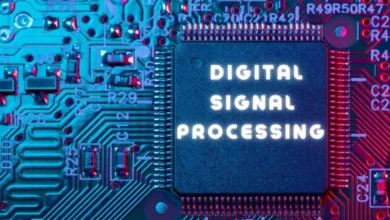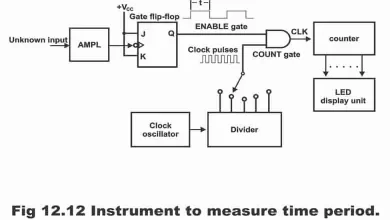Components of Micro Computers in Digital Electronics
Micro Computers
Components of Micro Computers in Digital Electronics- When a microprocessor is connected to a memory device and some source is provided for fetching data or transferring data to the outside world, it becomes a micro-computer. In other words, a microprocessor that has been connected with memory and interface modules (or input/output channels for communication with the outside world), is called microcomputer. A specific microcomputer consists of three basic units i.e. a microprocessor or CPU (which is normally a chip), memory (which is composed of several chips), and input/output interface (I/O). Remember that a microprocessor that is generally enclosed in an IC package is known as a microprocessor chip. However, some microprocessor chips are such that they comprise of a segment of memory as well apart from the CPU. This type of LSI component is sometimes known as a one-chip microcomputer.
In figure 11.6, a block diagram of a microcomputer has been illustrated, where in existing CPU (micro-processor) communicates between the memory unit and input-output units via multiple Buses (i.e. communication process keeps intact). Addresses are sent to memory by means of an address bus. CPU transfers data or instructions between memory and input-output units by means of the data bus. Whereas, in order to coordinate all operations mutually, signals are transmitted via the control bus.
Figure 11.6 – Microcomputer block diagram
Components of Micro Computers
CPU
Microprocessors and corresponding auxiliary circuit combine together in order to manufacture a CPU (central processing unit), which is also sometimes known as MPU (micro-processor unit). Basically, a CPU addresses a memory location, fetches program instructions stored therein and implements these instructions or executes them. After fulfillment of one instruction, CPU fetches another instruction so as to execute it and as such, this process of fetching and execution moves on, until all instructions of a specific program have been executed.
Memory Unit
Memory unit normally consists of a ROM, RAM and a disk. RAM stores data and programs temporarily during processing. Data and other information are in binary form, whereas programs are a list of instructions, which direct as to which task a computer has to undertake. As RAM is a volatile memory, therefore everything is provided a backup on non- volatile disk storage.
ROM stores system programs e.g. BIOS (basic input / output system). These types of programs are used to handle video display graphics, printer communications, power on self-test and other customary programs.
Input Unit
Microcomputer fetches information from outside world via input unit (which can generally handle a number of external devices, which are called peripherals). The peripherals, with which a computer communicates or set ups a communication network via these input units, its examples are keyboard and mouse.
Output Unit
Micro-computer transmits information to the outside world via an output unit (which can generally control or handle several peripherals). Examples of peripherals, with which a computer communicates via an output unit, are a video monitor and printer. Some of the peripherals are such, which can operate both as input as well as output devices e.g. external disks, drivers, video monitors and modems etc.
In figure 11.7, the organizational block diagram of a microcomputer system has been illustrated. Similar to a computer, this microcomputer consists of 5 basic segments i.e. input unit, control and arithmetic units (microprocessors), memory units, and output units.
Figure 11.7 – Block diagram of a micro-computer system
The microprocessor unit (MPU) controls all the system units by means of control lines displayed on the left side of the figure. Along control lines, an address bus exists (which consists of 16 parallel conductors), which selects some specific memory location, input port, or output port. The data bus (which comprises 8 parallel conductors) illustrated on the right side of this figure, operates just similarly to a two-way path, by means of which data is transmitted to MPU or data is transferred out from MPU. Here, it is worth mentioning that memory can transmit data on memory or output port or can fetch data from memory or input port.
Microprocessors ROM generally consists of a program. A program means a list of specially coded instructions, which actually tells MPU what task it has to undertake. The ROM displayed in the figure indicates a place, where this program stays. Practically, ROM is a start-up program and perhaps consists of some other programs (i.e. start-up program or some other program’s programming exists in ROM). Separate or external programs can also be loaded in RAM via an auxiliary memory. These types of programs are commonly known as user programs.
Memory sections and the CPU of a microcomputer are not useful by themselves, rather CPU is made useful by means of interfacing the CPU with peripheral devices being used for input, output, and storage. The peripheral devices being used for input, output, and storage of a modern microcomputer have been illustrated in figure 11.8. Amongst these, keyboard, mouse, and joysticks are probably such most commonly used devices that are attached to a majority of computers. However, apart from these devices, other input devices are also connected to microcomputers. This has been illustrated via a list of input devices towards the left of this figure.
Figure 11.8 – Peripheral devices commonly attached to the CPU of a microcomputer
The floppy disk drive is a popular secondary storage device, which is mostly used or employed with most of microcomputers. Other secondary storage devices being interfaced with microcomputers include hard disks and optical devices which are most commonly used. However, tap drives are also being used on a very low scale for this purpose. CRT monitors and printers are such types of peripheral devices that are commonly used with microcomputers. However, besides these output devices, other devices e.g. TVs, speakers, sound systems, plotters, and laser printers are also output devices.
The modem is also a peripheral device (remember that modem means modulator-demodulator) which enables a microcomputer to transmit data or receive data by means of telephone lines. Remember that when a modem transmits data, it is an output device at that time and when it fetches data, it then operates as an input device. That’s why it is also known as an input/ output peripheral device. This has been illustrated in the figure. In other words, a modem may be an input and output device as well (as has been indicated via a dual-edged arrow sign in the figure) because data can be transmitted to a microcomputer through telephone lines by means of a modem and data can also be received via telephone lines by means of a modem.
Previous Topic: Microprocessor Intel 80 x 86 and Motorola 680 x 0 Family
Next Topic: Type of Electronic Machine in Digital Electronics







